How to Prepare Your UK Vegetable Garden for Autumn: Complete Seasonal Guide
Transform your autumn garden preparation with our expert UK guide. Discover essential tasks for soil preparation, late-season sowing, and winter crop planning to extend your growing season and prepare for spring success.
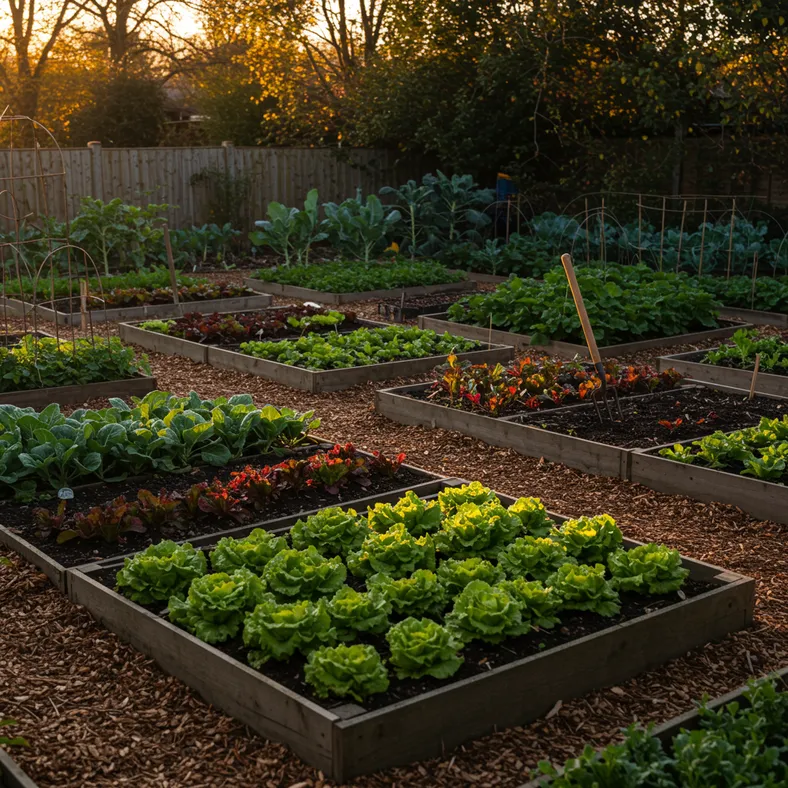
As summer fades and the first hints of autumn appear across the UK, many gardeners mistakenly believe their vegetable growing season is coming to an end. However, autumn presents a golden opportunity to extend your harvest, prepare for winter crops, and set your garden up for an early spring start.
With proper preparation, your UK vegetable garden can continue producing fresh food well into winter whilst simultaneously getting ready for the following year's success. The key lies in understanding which tasks to prioritise during this critical seasonal transition.
From late-season sowings that will thrive in cooler conditions to essential soil preparation that takes advantage of autumn rains and winter frosts, this comprehensive guide will walk you through every aspect of preparing your UK vegetable garden for the months ahead.
Late Season Sowing for Extended Harvests
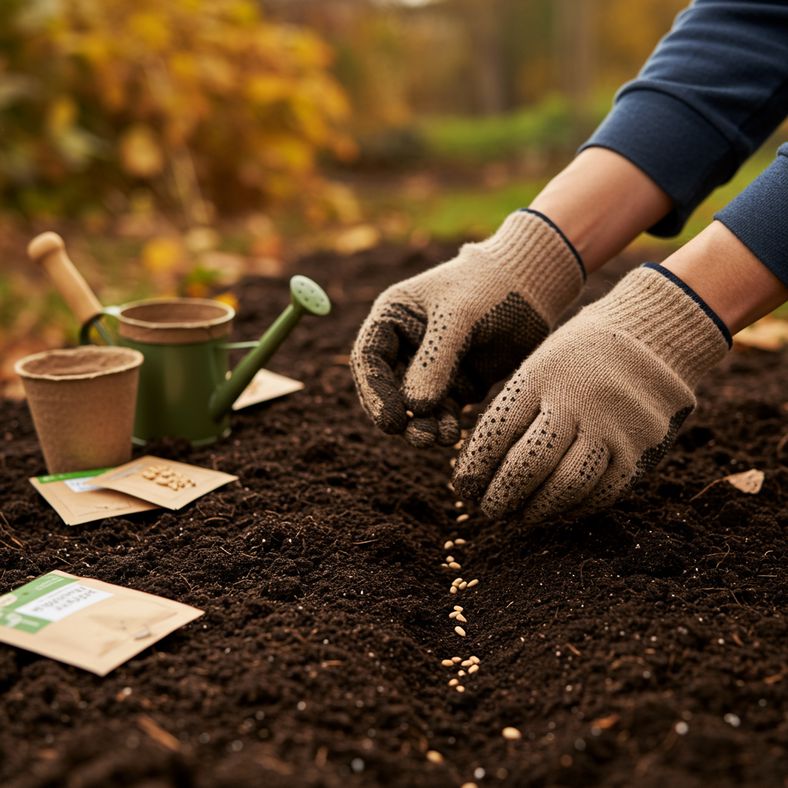
September and early October offer excellent opportunities for late-season sowings in UK gardens. The soil remains warm from summer whilst air temperatures begin to cool, creating ideal conditions for quick germination and steady growth.
Many gardeners are surprised to learn that certain vegetables actually perform better when sown in autumn rather than spring. The cooler temperatures prevent bolting in leafy crops, whilst the shorter days naturally regulate growth rates.
Quick-Growing Leafy Crops
Focus on fast-maturing leafy vegetables that can establish before the first hard frosts arrive, typically in late October or November across most of the UK:
- Oriental Leaves: Pak choi, mizuna, and mustard greens germinate rapidly in September and provide harvests within 6-8 weeks
- Spinach Varieties: Choose cold-hardy varieties like 'Giant Winter' which can withstand temperatures down to -10°C
- Winter Lettuce: Under cloche protection, varieties like 'Winter Density' will provide fresh leaves throughout winter
- Rocket and Watercress: These peppery leaves thrive in cooler conditions and add flavour to winter salads
For the best results with leafy crops, quality lettuce seeds ensure reliable germination in cooler soil temperatures.
Overwintering Vegetables
Plan ahead for spring harvests by sowing vegetables that will establish before winter and resume growth in spring:
- Broad Beans: Varieties like 'Aquadulce Claudia' can be sown from late September through November for early summer harvests
- Overwintering Onions: Sets planted in September will bulb up in early summer, weeks ahead of spring-planted varieties
- Garlic: October planting allows proper vernalisation for larger bulbs the following summer
- Early Peas: 'Feltham First' and similar varieties sown in October will crop weeks earlier than spring sowings
Essential Soil Preparation for Winter
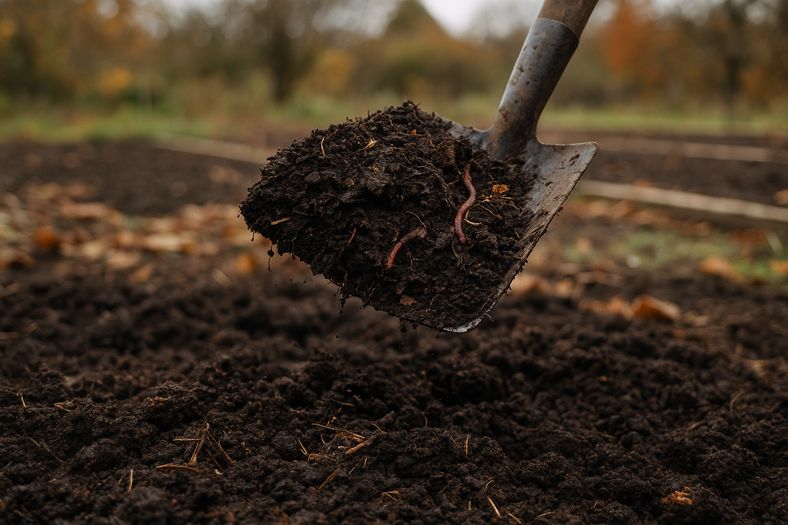
Autumn soil preparation is perhaps the most important task for ensuring next year's garden success. UK soils benefit enormously from autumn treatments that take advantage of winter weather to improve structure and fertility.
The timing of soil preparation varies across the UK depending on your soil type. Heavy clay soils should be prepared in early autumn, allowing winter frosts to break down large clods naturally. Lighter, sandy soils are better prepared in late autumn or early winter to prevent nutrient leaching.
Adding Organic Matter
Autumn is the ideal time to incorporate substantial amounts of organic matter into your vegetable beds:
- Well-Rotted Manure: Fresh manure can be applied to empty beds in autumn as it has all winter to decompose properly
- Garden Compost: Your own compost adds structure and fertility whilst recycling garden waste
- Leaf Mould: Collect fallen leaves now to create nutrient-rich soil conditioner for next year
- Mushroom Compost: Provides excellent soil structure improvement, though avoid on acid-loving crops due to its alkaline nature
Aim to add a 5-7cm layer of organic matter across all beds, digging it in to a depth of 20-25cm. This substantial addition will improve water retention in sandy soils and drainage in clay soils.
No-Dig Preparation Methods
Many UK gardeners are adopting no-dig methods that preserve soil structure whilst still improving fertility:
- Surface Mulching: Apply organic matter directly to the surface and allow worms to incorporate it naturally
- Cardboard Suppression: Lay cardboard over weedy areas, then mulch heavily for weed-free beds by spring
- Green Manures: Sow quick-growing crops like mustard or phacelia to protect and improve soil over winter
Green manures are particularly valuable for plots that would otherwise lie empty. They prevent soil erosion, suppress weeds, and add organic matter when dug in during spring.
pH Testing and Adjustment
Autumn is an excellent time to test and adjust soil pH, as any amendments have months to take effect:
- Lime Application: If soil tests reveal acidity below pH 6.0, apply garden lime in autumn for gradual pH increase
- Sulphur for Alkaline Soils: Overly alkaline soils (above pH 7.5) can be gradually acidified with sulphur applications
- Regional Considerations: UK soils tend toward acidity, particularly in high-rainfall areas of Scotland and Wales
Winter Crop Planning and Protection
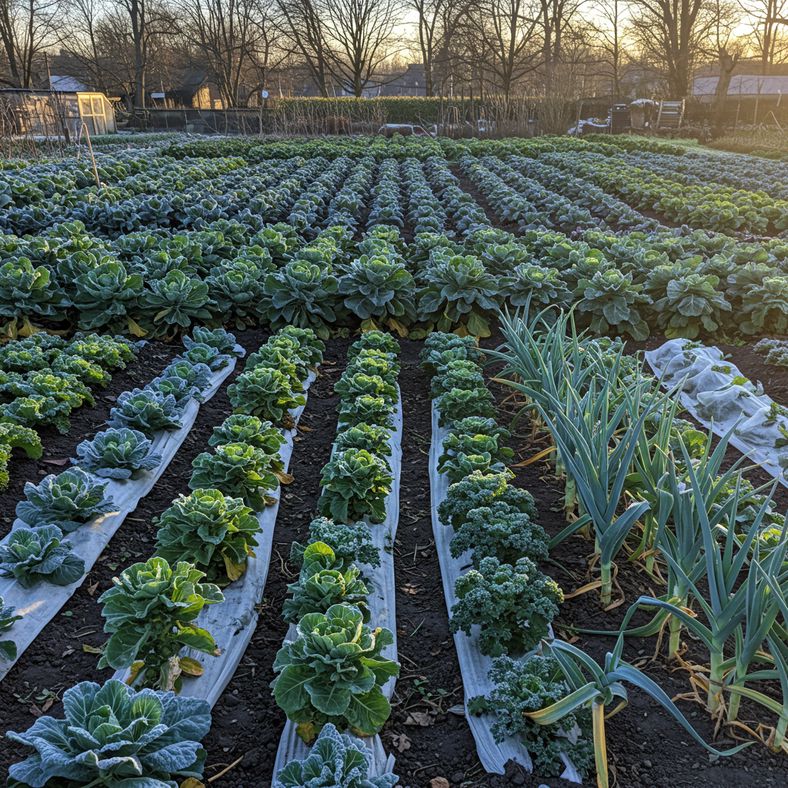
Strategic planning for winter crops can transform your UK vegetable garden from a dormant space into a productive winter food source. Success depends on choosing appropriate varieties and providing adequate protection from harsh weather.
UK winters vary significantly by region, with coastal areas experiencing milder conditions than inland locations. Understanding your local microclimate helps determine which crops will thrive with minimal protection and which require additional shelter.
Hardy Winter Vegetables
Focus on vegetables that not only survive UK winters but actually improve in flavour after frost exposure:
- Brassicas: Savoy cabbage, Brussels sprouts, and kale varieties become sweeter after frost as plants convert starches to sugars
- Root Vegetables: Carrots, parsnips, and turnips can remain in the ground until needed, improving in texture and flavour
- Hardy Greens: Perpetual spinach and Swiss chard continue producing leaves even in sub-zero temperatures
- Leeks: Perhaps the most reliable winter vegetable in the UK, providing harvests from autumn through to spring
These hardy crops form the backbone of winter vegetable production and require minimal protection in most UK locations.
Protection Methods
Simple protection methods can extend the growing season and improve crop quality during harsh weather:
- Fleece Covering: Horticultural fleece provides 2-4°C of frost protection whilst allowing light and air circulation
- Cloche Systems: Glass or plastic cloches create microclimates for tender crops and early sowings
- Cold Frames: Purpose-built cold frames enable year-round salad production in most UK areas
- Polytunnels: Even unheated polytunnels significantly extend the growing season for many crops
The key to successful winter growing is matching protection levels to crop requirements and local weather patterns.
Succession Planning
Plan succession sowings to ensure continuous harvests throughout winter and early spring:
- Monthly Lettuce Sowings: Sow small quantities of hardy lettuce varieties monthly through autumn for continuous supplies
- Radish Rotations: Quick-growing radishes can be sown every 3-4 weeks in protected conditions
- Microgreen Production: Windowsill microgreens provide fresh nutrition when outdoor crops are limited
- Sprouting Seeds: Indoor sprouting systems ensure year-round fresh greens regardless of weather
Garden Cleanup and Maintenance Tasks

Proper autumn cleanup prevents pest and disease problems whilst preparing your garden infrastructure for winter weather. A systematic approach ensures nothing important is overlooked during this busy seasonal transition.
The timing of cleanup tasks matters significantly in the UK climate. Too early removal of plant material can eliminate beneficial wildlife habitat, whilst leaving diseased material too long risks spreading problems to healthy plants.
Disease Prevention
Remove diseased plant material promptly to prevent problems overwintering and spreading next year:
- Blight-Affected Plants: All potato and tomato plants showing blight symptoms must be removed and destroyed, never composted
- Clubroot Management: Infected brassica roots should be burnt or disposed of in household waste
- Powdery Mildew: Affected leaves should be cleared promptly as spores can overwinter on plant debris
- Rust Diseases: Remove and destroy affected leaves from leeks, garlic, and broad beans
Clean tools with disinfectant between different areas of the garden to prevent spreading diseases inadvertently.
Beneficial Cleanup Practices
Balance disease prevention with wildlife conservation by adopting selective cleanup approaches:
- Hollow Stems: Leave hollow stems of plants like fennel and Jerusalem artichokes as these provide overwintering sites for beneficial insects
- Seed Heads: Retain seed heads on ornamental plants near the vegetable garden to feed birds through winter
- Leaf Piles: Create discrete leaf piles in quiet corners for hedgehogs and other wildlife
- Compost Management: Hot compost healthy plant material but dispose of diseased material separately
Infrastructure Maintenance
Prepare garden structures and tools for winter weather to prevent damage and ensure readiness for spring:
- Greenhouse Cleaning: Wash glass panels to maximise light transmission during low-light winter months
- Tool Maintenance: Clean, oil, and sharpen garden tools before storing for winter
- Irrigation Systems: Drain and protect outdoor water systems from frost damage
- Support Structures: Check and repair trellises, stakes, and plant supports damaged during the growing season
Quality tools make garden tasks easier and more enjoyable. Consider upgrading essential tools like professional secateurs that will last for years with proper care.
Preparing Greenhouse and Protected Growing
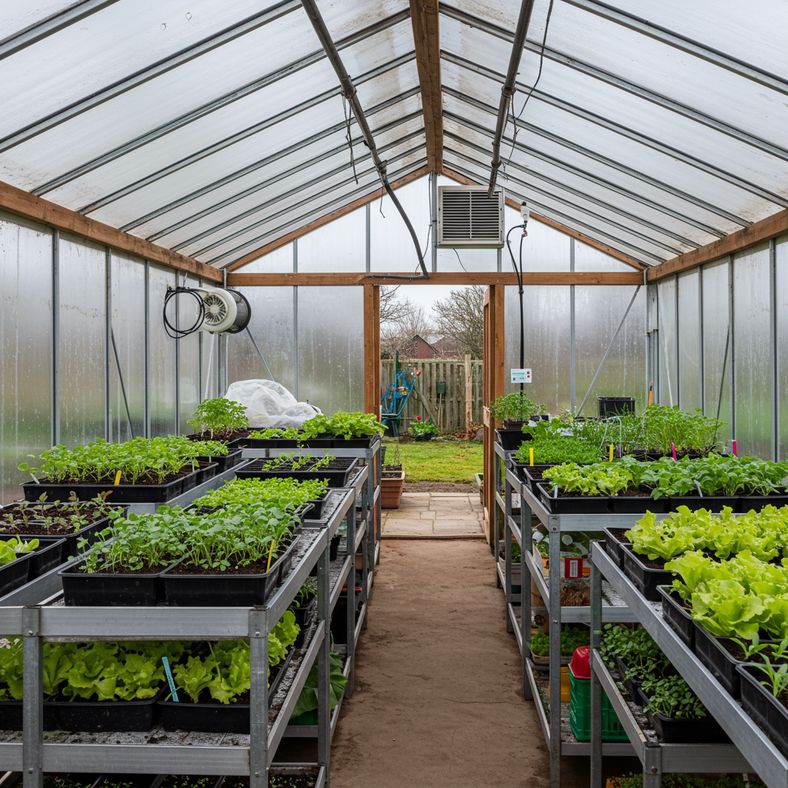
Greenhouse preparation is crucial for maximising winter growing potential in the UK climate. Even unheated greenhouses can significantly extend the growing season and provide protection for tender crops during harsh weather.
The key to successful greenhouse growing through winter lies in optimising light transmission, maintaining good air circulation, and managing humidity levels to prevent fungal diseases.
Greenhouse Hygiene and Setup
Thorough cleaning and preparation prevents disease problems and optimises growing conditions:
- Glass Cleaning: Clean both interior and exterior glass surfaces to maximise precious winter light
- Disinfection: Use greenhouse disinfectant to eliminate overwintering pests and diseases
- Insulation Options: Bubble wrap insulation can provide frost protection whilst maintaining reasonable light levels
- Ventilation Management: Adjust automatic vent openers for winter conditions and ensure manual control during extreme weather
Winter Growing Systems
Develop systems that maximise productivity during the challenging winter months:
- Staging and Shelving: Multi-level growing systems make best use of limited space and capture different light levels
- Heated Propagation: A small heated propagation area enables early seed starting and extends the sowing season
- Cold Frame Integration: Use cold frames as stepping stones between greenhouse and outdoor conditions
- Container Growing: Pot-grown crops can be moved for optimal conditions and protection
Crop Selection for Protected Growing
Choose crops specifically suited to protected winter growing conditions:
- Salad Crops: Lettuce, mixed radishes, and cut-and-come-again leaves thrive in cool greenhouse conditions
- Herbs: Mediterranean herbs like rosemary and thyme appreciate protection whilst remaining accessible for kitchen use
- Microgreens: Fast-growing microgreens provide nutrition and flavour when outdoor crops are limited
- Early Sowings: Start next year's crops early for transplanting when conditions improve
For optimal results with winter salads, ensure adequate spacing to promote air circulation and prevent fungal diseases.
Seed Ordering and Planning for Next Year
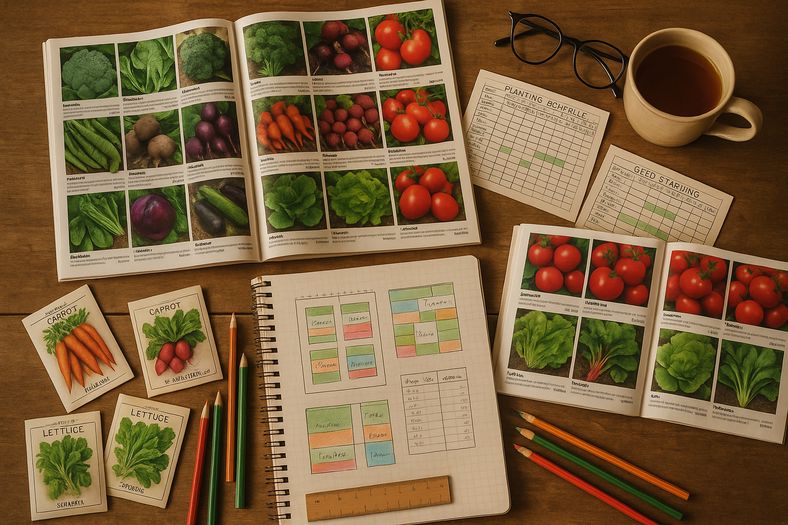
Autumn is the perfect time for reflective planning and seed ordering for the following year. Use the experiences of the current growing season to inform better choices and more successful plantings next year.
Many seed companies offer early bird discounts during autumn months, making this an economical time to plan ahead. Additionally, popular varieties often sell out by spring, so autumn ordering ensures availability.
Crop Rotation Planning
Plan next year's layout to optimise soil health and minimise pest and disease pressure:
- Four-Year Rotation: Rotate brassicas, legumes, root crops, and others in a systematic cycle
- Soil Improvement: Plan nitrogen-fixing legumes for areas that hosted heavy feeders this year
- Companion Planting: Consider beneficial plant combinations when planning bed layouts
- Space Optimisation: Plan succession sowings and intercropping to maximise productivity
Variety Selection
Use this year's experience to inform better variety choices for UK growing conditions:
- Climate Adaptation: Choose varieties specifically bred for UK conditions and shorter growing seasons
- Disease Resistance: Select varieties with resistance to problems encountered this year
- Harvest Timing: Plan varieties that mature at different times for extended harvests
- Storage Qualities: Include varieties that store well for winter use
Infrastructure Planning
Assess current infrastructure and plan improvements for next year:
- Support Systems: Plan trellis and support upgrades for climbing crops
- Water Management: Consider irrigation improvements for dry spells
- Storage Solutions: Plan improved storage for tools, seeds, and harvested crops
- Accessibility: Design paths and bed layouts for easier maintenance
Consider keeping a garden journal throughout winter to record observations and plans. This invaluable resource will inform decision-making for years to come.
Disclaimer: This article contains Amazon affiliate links. We may earn a small commission from qualifying purchases at no additional cost to you.